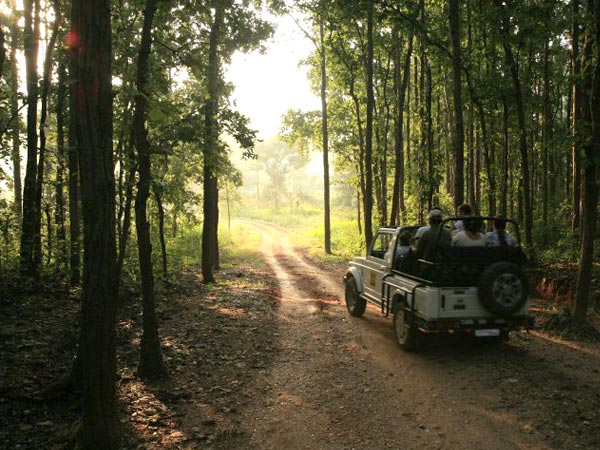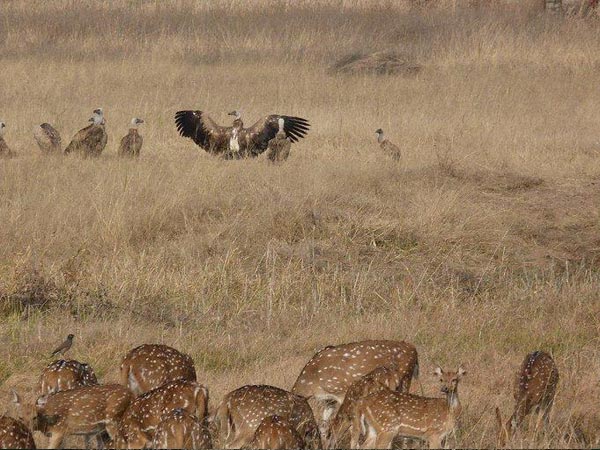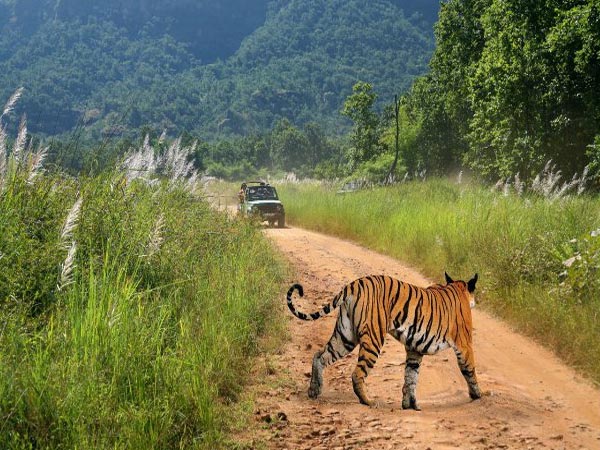It’s November and a weak winter sun has just begun to worm its way under my many layers of woollens. Our guide for our trip to Bandhavgarh National Park, at the wheel of the jeep, has been leaning over the door for a while, examining a large set of pugmarks and muttering under his breath. “Should be a tiger here somewhere,” he says fretfully. Twenty seconds later, we go round a bend in the forest road and, as I raise my eyes, I hear him say, “Tiger on the road! Tiger on the road!” The tiger is walking deliberately down the exact centre of the path with the lazy gait of the all-powerful. There is no doubt in the mind of either the tiger or the tourists that the road belongs to him. He is a study in raw health. The sun glances off his coat and the tips of his whiskers. His colour is not the flame red or orange of drawing books, but a true and buttery gold, like silk lit up from within. His massive head sways a little, a large furry ball; the rest of him is muscle and sinew. He shines. The guide edges up very close, so that we’re following at a distance of 15 ft. The big cat doesn’t even look around. He stops at a tree, turns his magnificent profile to us and raises his tail to spray the bark. Another jeep, approaching from the other side, can see neither him nor us and our frantic ‘Stop!’ signs. As the vehicle rounds the bend and slams to a halt, the tiger, squeezed between two vehicles, lets out an annoyed roar and steps off the road into the jungle.
Most forests are full of surprises and beautiful, occasionally transcendental moments. But there is nothing to beat one’s first sighting of a tiger in the wild. And to hear old hands tell it, every time is like that magical first time, marked by the same suspension of breath, the same dreadful awe, the same rearing of the most basic human instincts — attraction to beauty and fear of the predator. This is my first time, here in Bandhavgarh National Park, a small tract of protected forest in Madhya Pradesh that was once the shikargarh (game reserve) of the maharajas of Rewa. We follow the tiger’s progress via disgruntled bellows emanating from the undergrowth, then race down to catch him emerging to cross the road at another point. A quick exchange with other jeep drivers establishes that he’s on his way to a rendezvous with his mate, a tigress with four cubs, who is lying up in the tall grass at the edge of the forest some distance away.
As soon as the beast has disappeared for the second time, we pelt up the road to where Forest Department elephants are saddled up and already ferrying tourists back and forth for a close look at the mother and cubs. Twenty-five vehicles are standing in line, full of people waiting for their turn on one of the three elephants, the third a young female who is not yet fully grown. While the male tusker and the adult female stroll back and forth with a certain cynical weariness, this little lady trots around like the eager-to please trainee she is. We leap off the jeep and onto the huge tusker — I’m rather pleased about this because we’ll be a good 12 ft off the ground, and while a tiger is an unspeakably beautiful thing, it is also terrifying, and there is such a thing as getting too close to one. While all this going on around me, I got to realise that Bandhavgarh is known for having the highest density of tigers of any National Park in the country — despite the fact that the erstwhile rulers enthusiastically adhered to the belief that it was lucky for the monarch to shoot, for some reason,109 tigers!
Our elephant sets off down a grassy path to where the other elephants are standing. The approach is fortuitous: the tigress sees everyone coming a long way off, no surprises. Still, it’s amazing to me that in the face of three huge beasts standing 5 ft from her, with enormous camera lenses trained on her and the occasional whispered comment from the tourists, she doesn’t turn a hair. I’m in awe of how unconcerned about our presence the tigress and her cubs are. In fact, she’s so unruffled that she barely opens her eyes; and soon enough she stretches out and falls asleep, the white on her face and belly whiter than any Surf-washed shirt. She and the cubs are recuperating from an enormous meal of cheetal, the carcass of which is lying next to her; one cub is snoring on his back with all his paws in the air and his distended little belly soaking in the sun; the other is still feeding on the deer. The other two have apparently gone off to play in the forest. We watch for a couple of minutes, and the mahout considerately turns the elephant around so that everyone gets a good look. Eventually, we turn around and lumber back to the road. Back in the jeep, we watch the tigers for an hour through the binoculars and the tall grasses; for a second, the mother’s great striped face looks me straight back in the eye and my knees turn to water even as my heart leaps with excitement. And yes! there were many; no wonder it has in the last few years become as synonymous with the tiger as Ranthambore or Kanha.
Bandhavgarh’s so-called Tiger Show gave a chance to visitors who missed sighting a tiger to catch them on an organised safari. These have now been discontinued. Sadly, many tourists feel their trip has been wasted if they don’t see a tiger. They miss out on the many other things that make up a fabulous forest experience: the smaller animals, like deer and wild boars; the birds; the crisp morning air; the beautiful mossy, grassy, twiggy, leafy, watery forest environment itself. Even the most common of animal sightings can be magical: a stag standing stock-still in a clearing in the half-light; a wild mother boar leading her piglets carefully through the brush; an Indian roller taking flight, flashing its sky-blue wings. And then there is the endlessly varied beauty of the forest, made different at every moment by mood and ambience, by a trick of light, of weather, of temperature. To check out what else the state of Madhya Pradesh has to offer, check out this cool travel guide.
Some quick facts:
Location
Bandhavgarh lies in eastern Madhya Pradesh, in the northernmost spur of the Maikal Hill Range in the Vindhyas, which it shares with Kanha (located 160 km to the south), in Shahdol District
Distances
34 km NE of Umaria, 101 km E of Katni, 483 km E of Bhopal, 565 km SE of Gwalior
Route from Bhopal
NH12 to Jabalpur via Obaidullaganj and Suatala; NH7 to Katni; NH78 to Umaria; SH11 to Bandhavgarh.
When to go:
November-March for travelling comfort; May- June for the best wildlife sightings. Temperatures vary from 0-20ºC in winter, and go up to 46ºC in the summer
Park closes from July to October, when the monsoon makes traversing it impossible.
Go there for Tigers Wildlife/ Forest Dept office. Field Director Umaria Tel: +91-7653-222214.
By Kshitiz







